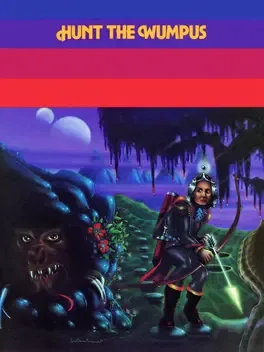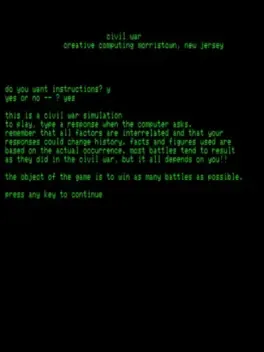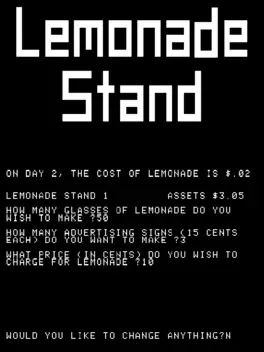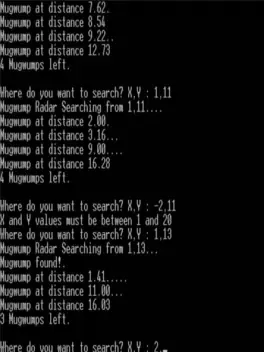Popular games for platform Microcomputer

Hunt the Wumpus is an early computer game, based on a simple hide and seek format featuring a mysterious monster (the Wumpus) that lurks deep inside a network of rooms. It was originally a text-based game written in BASIC and has since been ported to various programming languages and platforms including graphical versions. The original text-based version of Hunt the Wumpus uses a command line text interface. A player of the game enters commands to move through the rooms or to shoot "crooked arrows" along a tunnel into one of the adjoining rooms. There are twenty rooms, each connecting to three others, arranged like the vertices of a dodecahedron or the faces of an icosahedron (which are identical in layout). Hazards include bottomless pits, super bats (which drop the player in a random location, a feature duplicated in later, commercially published adventure games, such as Zork I, Valley of the Minotaur, and Adventure), and the Wumpus itself. The Wumpus is described as having sucker feet (to escape the bottomless pits) and being too heavy for a super bat to lift. When the player has deduced from hints which chamber the Wumpus is in without entering the chamber, he fires an arrow into the Wumpus's chamber to kill it. The player wins the game if he kills the Wumpus. However, firing the arrow into the wrong chamber startles the Wumpus, which may cause it to move to an adjacent room. The player loses if he or she is in the same room as the Wumpus (which then eats him or her) or a bottomless pit.

A turn-based, strategic simulation of fourteen real battles of the American Civil War. In single player mode, you play as the Confederacy, while the computer controls the Union. Each turn you have to decide how to allocate your funds on food, ammunition and salaries and choose one out of eight strategies to use in battle (four offensive, four defensive). The sides with fewer casualties wins the battle, and whoever wins eight or more battles wins the war. The game was developed at Lexington High School by students L. Cram, L. Goodie, and D. Hibbard. In 1973, it was compiled and published on "101 BASIC Computer Games" by David H. Ahl, who credited G. Paul and R. Hess of "TIES" for adding a two-player mode

Lemonade Stand is a business simulation game created in 1973 by Bob Jamison of the Minnesota Educational Computing Consortium. Charlie Kellner ported the game to the Apple II platform in February 1979. Throughout the 1980s Apple Computer included Lemonade Stand (along with other software) with the purchase of their systems. The game simulates a child's lemonade stand, where choices made by the player regarding prices, advertising, etc. will determine the success or failure of the enterprise. The game owed its success to offering just enough variables to make a complex challenge for users, but still providing a simply-grasped addictive introduction to the offsetting priorities facing a business. The choice of the right prices and quantities on the day of a heat-wave could instill the satisfaction unique to a greatly profitable private enterprise. The player is first given a weather report for the day (sunny, cloudy or hot and dry, each accompanied by a color drawing) and is prompted for three values: the number of glasses of lemonade to make, the number of advertising signs, and the cost of lemonade per glass. The program then gives a report of the earnings for that day. A thunderstorm, sometimes occurring on cloudy days and accompanied by a color animation, will void any profits and cause the player to lose any investment for the day. The game can be played either single-player or with up to 30 players (each player is independent and the sales of one do not affect another). The Apple II version included music, with bars from "Morning Mood," "Singin' in the Rain," "Raindrops Keep Fallin' on My Head," and "Summertime" played at appropriate moments.

Discover "Will Jump," a captivating platformer that immerses you in a retro universe filled with challenges. Play as Will, a fearless locksmith, a hero who races with his keys. Get ready to conquer 23 thrilling levels spread across 6 unique biomes. With its "die & retry" gameplay, each attempt will bring you closer to victory or a nervous breakdown. Dive into this pixelated adventure and take on the challenge of conquering each platform!

Mugwump is an early video game where the user is tasked with finding four "Mugwumps" that are randomly hidden on a 10x10 grid. It is a text-based game written in BASIC. The user enters a pair of single-digit co-ordinates in the range from 0 to 9 which are the x,y coordinates to scan. If a mugwump is at that location then the user is alerted. Otherwise the user is told the distance from the scanned coordinates to each of the mugwumps that are yet to be found. The game ends after ten turns or when all of the mugwumps have been found.

Hezarin is a text-based adventure developed in 1980 by Steve Tinney, Alex Shipp and Jon Thackray.